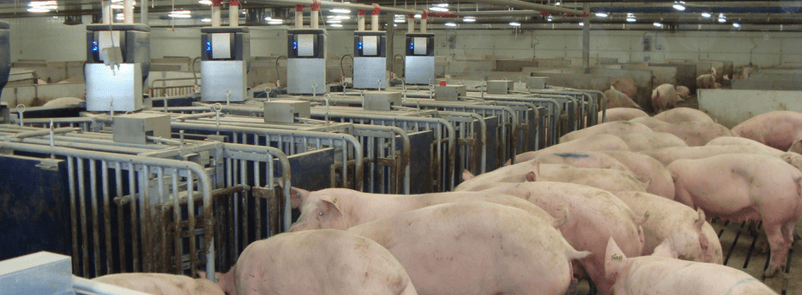
How you design for and manage your Electronic Sow Feeding systems in your barn is key to a high functioning sow unit. When a feed station is incorporated poorly into a pen, it is certain to cause a myriad of problems, increasing sow stress and reducing your production. When designing feed stations into a barn, we take the time to understand your managerial approach along with your employees' and animals' needs to make your barn highly effective and negate sow stress and digestive issues. As important as the ESF configuration and design is, how you manage your barn is even more crucial. Here is some insight on how we suggest you manage feed cycles once your group housing facility is up and running.
Understanding the Social Sow
When putting together a hog barn design, you must take into consideration a key social need of sows. For a defined portion of the day, they should lay down and rest as a community. This is natural for the sow herd, and we try to promote or foster this as much as possible. We believe strongly that sows can be encouraged to develop good habits and our designs reflect that; we think it is better to foster good habits, not force desired activity. With the understanding that they will, as a large community, lay down and rest, we design our overall feed strategies and ESF designs to give the animals the time they need instead of forcing them into the next activity. This leads us to two more significant factors in design and management: feed start times in relation to staff work schedules and how many animals to put on each feed station.
Staff Schedules and Feed Cycles
With a good sow barn design, we’ll want 85 – 90% of the sows that desire to eat to be able to do so within the first twelve hours of a 24-hour feed cycle. When most sows or gilts can get their allotted ration in the first twelve hours after the cycle starts, they will naturally rest as a group for the second half of a 24-hour cycle. We’ll then want the barn staff to perform their daily chores on the non-feeding times (the second half of a 24-hour cycle). This ensures that the pigs can eat on their own schedule and in peace; we don’t want them to be poked, prodded or otherwise disturbed when they are focused on food. During the resting period, the girls are calmer and your employees are less likely to cause irritation amongst them. With this in mind, we set the 24-hour feed time to start late in a work day so the girls can eat when they are not being disturbed by people. When the staff comes in the next morning to check up on girls and perform daily chores, the sows are, for the most part, sedate and loafing around.
As mentioned in my previous blog, we program the feed rations to dispense so even the slowest eating animals do not feel rushed. By considering the feed dispensing speed and the need to feed most sows in 12 -14 hours, we can calculate the number of sows we can safely put on a station without going outside our parameters. The final number of sows or gilts per ESF feed station will vary from barn to barn due to overall design but ultimately, we’ll calculate so that there are less than 55 sows per ESF station and less than 45 gilts per feed station.
Designing for Parity and Size
Sows and gilts are each unique animals. Sows being older will naturally be significantly larger than gilts but will also have different responses to other animals. Gilts are more easily distracted, haven’t developed as many habits and will interact differently with each other.
Due to the traits present in the different maturity levels of the animals, it is best that the two age groups are kept separate during gestation. I’ll delve further into the differences in sow and gilt pens in a later post but in relation to feeding and feed strategies, gilts and sows need to be accommodated as separate animals. We’ll have the gilts and sows separated as a matter of design but gilts do not eat as efficiently as sows, nor do they use the ESF stations in the same fashion. The sows are very proficient at getting into a station and getting right to the trough to eat, whereas a gilt may wander in more slowly and sniff around while meandering up to the trough. Once she (the gilt) does begin to eat, she’ll get distracted more easily and pause to look around. When her allotted feed is completely dispensed, she also takes longer to clean up the last bits. These little eating traits that are unique to less mature animals will add up to extra time that she needs in the feed station. Our parameters still call for all girls to be able to eat in 12-14 hours, thus the reason we do not calculate for as many gilts on a station as we can for sows.
Our Training Process
A group housing facility's success completely depends on how it is managed by the employees. When employees are well-educated and trained on our processes and reasons for the barn layout, they are able to better serve the animals and the barn. After we design and build your barn, we will continue to train and educate you and your staff over the life of the building to ensure its success. We will work with you to develop good feed cycle practices that are tailored specifically to your barn and animals. New Standard is devoted to assisting you in producing positive results in your hog production and making sure the barn operates efficiently.
If you are interested in learning more about our training process or would like to set up a barn design consultation, please click the button below and fill out the form.




